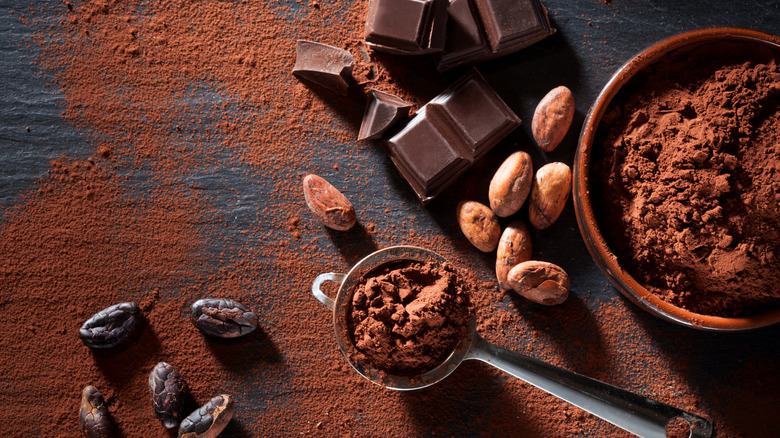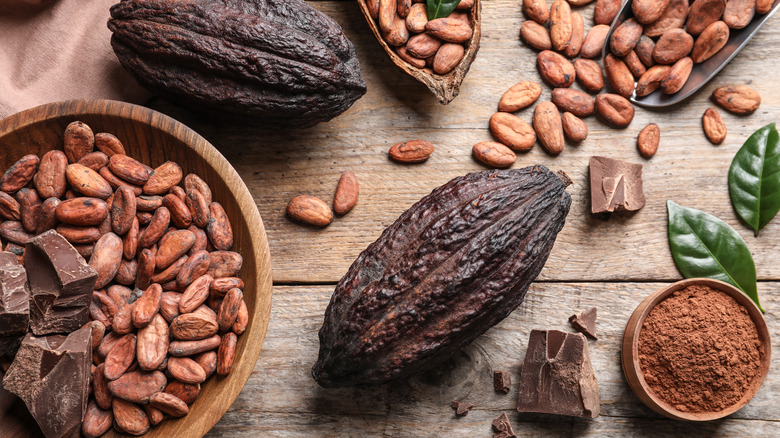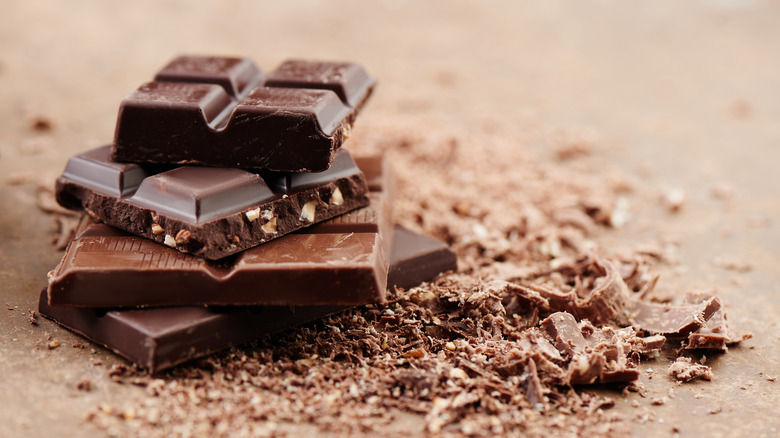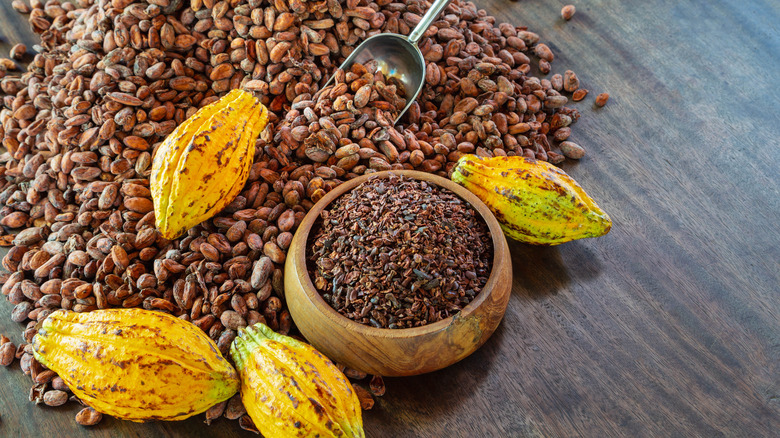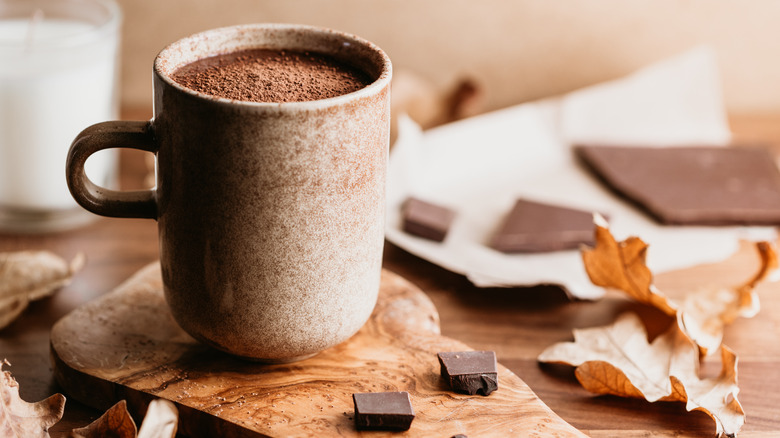Cocoa Vs. Cacao: What's The Difference?
Chocolate: Is it cocoa or cacao? Well, confusingly, it's kind of both, but whatever you call it, it's a thing so good it's scientific name, Theobroma, literally means "food of the gods." That's not just some modern chocolate obsessive talking either, as Cornell says the Mayans and Aztecs who first made use of the cacao tree believed that the plant was a gift directly from the gods themselves. We're not ones to argue with the gods' judgment either — chocolate is a peak dessert and ingredient, something that can take a million different forms and improves almost any sweet dish it's added to.
Chocolate is such an obsession that's become synonymous with flavor, pleasure, and happiness, in contrast to the unfairly maligned vanilla. We make it into ice creams, we dip fruit in it, and we even make a cake called "death by chocolate." But for something we're so crazy about, how much do we actually know about what chocolate is or where it comes from? Well that is where the difference between cocoa and cacao comes into play.
The two come from the same place, but are not the exact same thing.
What is cacao?
Cacao can be confusing because the word can be used to describe a few different things. According to Eater, cacao is first and foremost the fruit that grows on the cacao tree, which was originally cultivated in Mesoamerica by the Olmecs. Cacao is actually the original pronunciation for both cacao and cocoa, and it's still said that way in cacao producing areas, with the "cocoa" variation developing as a corruption of the original word. Today cacao is cultivated in tropical regions all over the world, with West Africa leading the way. The cacao fruit itself are large football-sized pods, which have a thick rind that contains white flesh surrounding dozens of large seeds.
These seeds are what you are likely to see marketed to you as cacao in stores and referenced in recipes. McCormick says cacao is essentially cocoa in its most raw form, before it's shipped off to be made into chocolate. The seeds are minimally processed and used to produce a range of products including cacao nibs, powder, and butter. The actual fruit flesh of cacao is not something you see as much outside of the countries where it's produced, but the seed products have become much more widespread.
Because it's minimally processed, cacao has a more bitter, savory flavor to it than what you would expect from cocoa or chocolate.
What is cocoa?
Cocoa is the term you are probably much more familiar with and is used pretty interchangeably with chocolate itself. Cocoa comes from processing cacao seeds, with The Spruce Eats explaining that cocoa is manufactured by simply roasting cacao. Both cacao and cocoa are fermented, but the extra high heat cocoa is treated with means it has a less bitter flavor than cacao, but also loses some of its nutritional value according to All Recipes. Processed and packaged cocoa also sometimes contains added sugar and dairy.
Both cacao and cocoa have that familiar chocolate flavor, but cocoa is the sweeter version we all know and love. We have the Spanish to thank for our modern chocolate we use in our cakes and pastries, as Eater says they were the ones who carried it back to Europe from the Americas, and are the first ones to be recorded mixing sugar with cacao. True to its more manufactured nature, cocoa goes through a variety of other processes after roasting, being cooled, mixed with additives, and kneaded until it obtains the factory's desired qualities, like the potassium carbonate added to Dutch process cocoa that lowers its acidity, per The Spruce Eats.
How to cook with cacao
Cacao has a wide variety of uses in both sweet and savory dishes. Bon Appétit says the two most common and easiest to use varieties for people unfamiliar with cacao are nibs and powder. Nibs are crumbled raw cacao beans, while the powder is similar to cocoa powder in it's uses, but with cacao's ultra-concentrated dark chocolate flavor. In Central America, cacao is commonly mixed into drinks, and can be used to upgrade your hot chocolate, or mixed into smoothies. Cacao is also used in stews and sauces, adding an extra layer of savory complexity, like in the classic Mexican dish mole negro.
Baking is also a great place to experiment with cacao. The nibs have a crunchy but chewable texture, similar to nuts, and Serious Eats says you can scatter them over ice cream or use them in cookies. Of course you don't want to ignore the obvious either: Cacao brownies are a winner. However you are starting out with cacao, it's best to use it with a light hand first so you can get used to the flavor. Try it as a garnish on chocolate dishes, or in place of nuts in salads, then you can start moving on to more cacao-heavy recipes.
Can you swap cacao for cocoa?
Generally speaking, their similar flavor profile means you can substitute out cacao for your favorite chocolate brand, but according to Kitchn, you want to be careful with cacao's more bitter flavor. Cacao is more intense than cocoa, so you may want to scale back how much you use when substituting. You might need to add extra sweeteners to a hot cacao drink or baked goods if you want them to stay closer to that chocolate flavor, while still getting the more complex notes of cacao. Be prepared to test recipes multiple times when doing a swap as cacao can react differently to things like baking powder, and you may get some unexpected results.
Besides its unique flavor being a big benefit of swapping cacao for cocoa is the former's nutritional value. As noted before, cacao is more raw, and Bon Appétit says that it is considered a superfood, with lots of antioxidants and plenty of iron and calcium. Cacao is also a source of flavonoids, which have been shown to have a beneficial effect on blood flow. While using cacao isn't exactly going to turn your chocolate torte into health food, it's still a nice way to get some of that chocolate fix and some extra vitamins at the same time.
Whether you think of it as raw chocolate, or as its own unique ingredient, cacao has great properties and versatility that should make it a welcome addition to your pantry.
